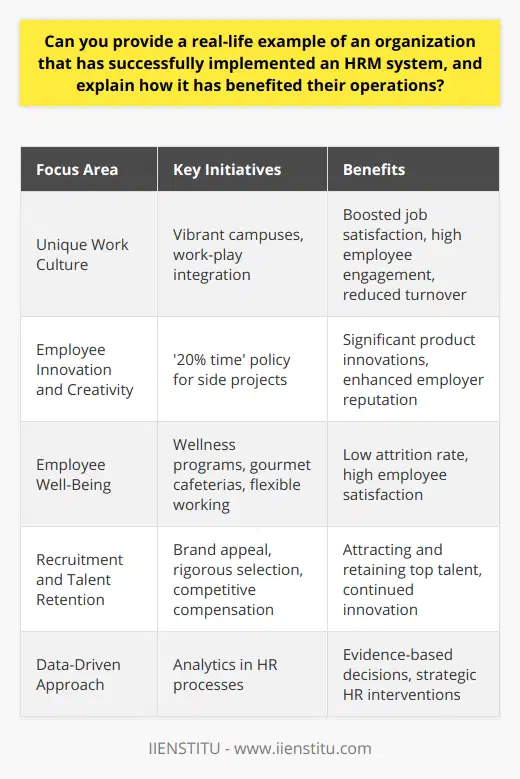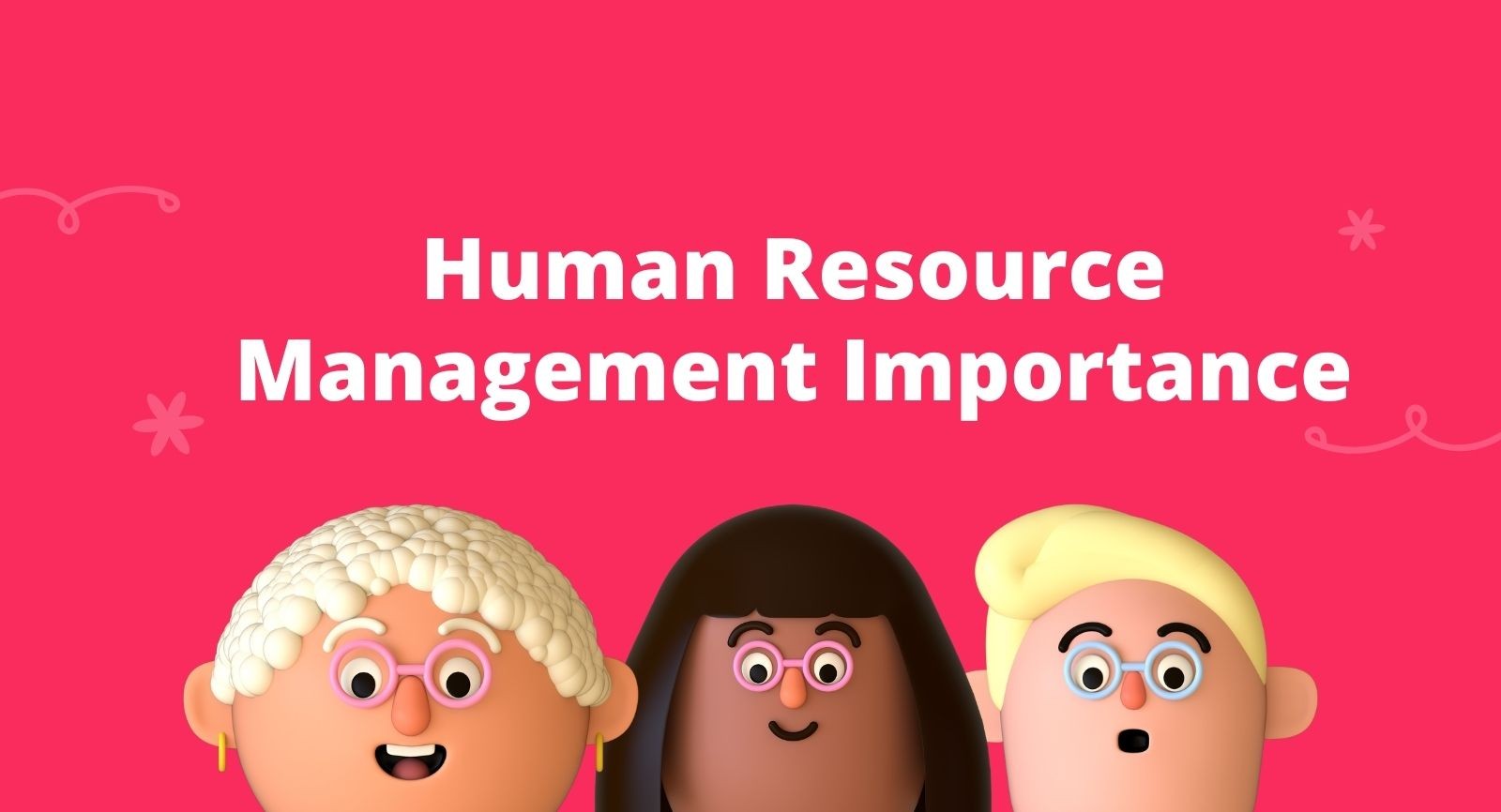
The human resource management system is a necessary part of an organization. It can also be considered one's most significant treasure because it helps with the recruitment, hiring, and evaluation processes and provides security measures to protect company secrets from being leaked out or stolen by employees. In addition, human resource management systems are specifically designed to help human resources managers recruit new talents, train current staff, and reward excellent performance done by their subordinates. This human resource management information system is vital to an organization because human capital plays a significant role in determining the success or failure of an organization. Therefore, human resource management is more than just a human resource information data system.
Summarize
What Is The Human Resource Management Information System?
What Is The Human Resource Management System?
How Do HR Systems Get Employees Hire?
How Does A Company Approach Its Employees With An HR System?
What Is The Human Resource Management Information System?
The beginning step is the human resource information data system when implementing a human resource management system. Human resources managers worldwide rely on management to support their human capital development activities. Therefore, HRMS, also known as human resources management information system, is a vital element of human resource management, providing a dataset for human resources managers to make business decisions.
The primary function of HRMS or human resource management information is to provide human resource managers with valuable tools that may help them to maintain their current personnel effectively and minimize their costs. These systems are not just used by the higher-ups but also for employee internet access to have ease in searching for human resource information data systems. In addition, human resources managers use human resource management to get general personnel data, human capital metrics, and reports to help them make decisions.
Human resource managers must be able to gather all the human resources information data systems they need without involving higher-ups who may be having another plan because the human resources department should have full authority to perform its tasks proper for example, within the HRMS systems, human resources managers could provide effective employee training programs, manage the salary of their employees and also make sure that employees do not disclose any company's secrets.
HRMS helps employers by providing human resource information with human capital metrics. In addition, human resources managers employ human resource management to create human capital plans and information data systems that help them manage their employees. HRMS or human resource management is one of the most critical components in any successful business. Without it, the human resources department would be useless no matter how big or small the organization is.
What Is The Human Resources Management System?
Many human resource managers fail to plan their workload correctly, resulting in inefficient use of their time and effort, making it difficult to train new hires, create evaluations, and sometimes even monitor their current workforce effectively. Human resources managers can automate the tasks that make them easier to use and manage using an HRMS or human resources management system.
Besides, the human resources management system can also help employers with their human capital planning by providing human capital metrics that are essential in measuring the effectiveness of human resources management in an organization. With this human resource information data system, the human resources department can identify any areas that need improvement and make the necessary changes to work more effectively.
Most human resource managers use HRMS or human resource management systems to get general personnel data, human capital metrics, and reports to help them in their decision-making. However, some managers are still reluctant to implement HRMS due to its cost. Human resource managers need to realize that HRMS can save them time and effort. In addition, human resources management can provide human capital metrics to help human resource managers make human resources management the best it can be for the benefit of both the company and its employees.
How Do HR Systems Get Employees Hire?
There are a few different ways that an HRMS can get employees hired. One way is by creating job postings, screening resumes, and conducting interviews. This can save time and money for businesses and make the process more efficient. Additionally, many HRMSs includes modules that allow businesses to track employee performance and conduct reviews. Human Resources can use this information to identify potential employees who may be a good fit for jobs within the company. Finally, some HRMSs includes modules that allow employers to manage payroll and benefits. All of this information can help make decisions about who to hire.
There are several benefits to using an HRMS when hiring employees. First, businesses can save time and money by automating the process and tracking employee performance. Additionally, companies can use the information from HRMS modules to make more informed decisions about who to hire. Ultimately, this can lead to a more efficient and effective hiring process.
How Does A Company Approach Its Employees With An HR System?
When a company is looking to implement an HR system, there are a few different ways to approach its employees. One way is to announce that a new HR system is being implemented simply, and all employees will be required to use it. However, this can be a hard way to roll out a new system, as it can often lead to confusion and frustration among employees. A better way to introduce an HR system is to gradually roll it out, allowing employees to become familiar with the new system and its features. This allows for a smooth transition and makes it less likely to feel overwhelmed or frustrated by the new system.
Another essential factor to consider when introducing an HR system is how it plans to use it. For example, if the system is being used mainly to track employee data, employees should be made aware of what information will be collected and how it will be used. Employees should also be allowed to provide feedback on the new system and any concerns about its use. By communicating openly with employees and addressing their concerns, companies can help ensure that employees are comfortable with the latest HR system and are more likely to use it effectively.
Check out our human resources management course if you're looking for HRMS information systems and HRM processes. Then, join IIENSTITU and learn from experts!
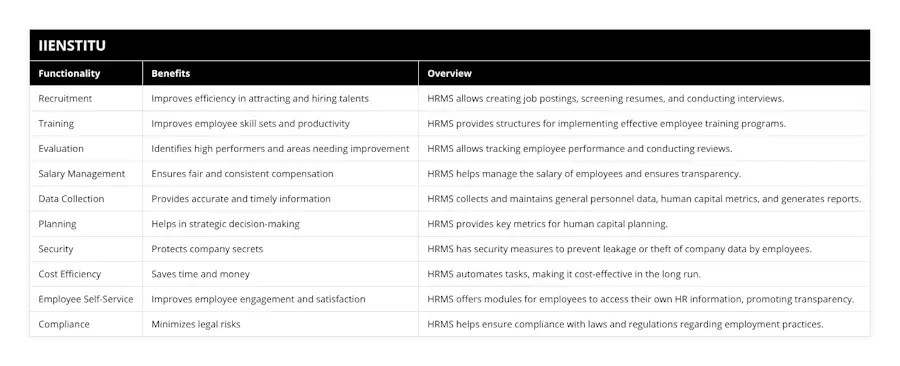
Frequently Asked Questions
What Is The Human Resource Management Information System?
The beginning step in implementing a HRMS is to collect human resource information.

What Is The Human Resource Management System?
HRMS software automates tasks in human resources management.

How Do HR Systems Get Employees Hire?
HRMSs can be used to track employee performance, screen resumes, conduct interviews and more.
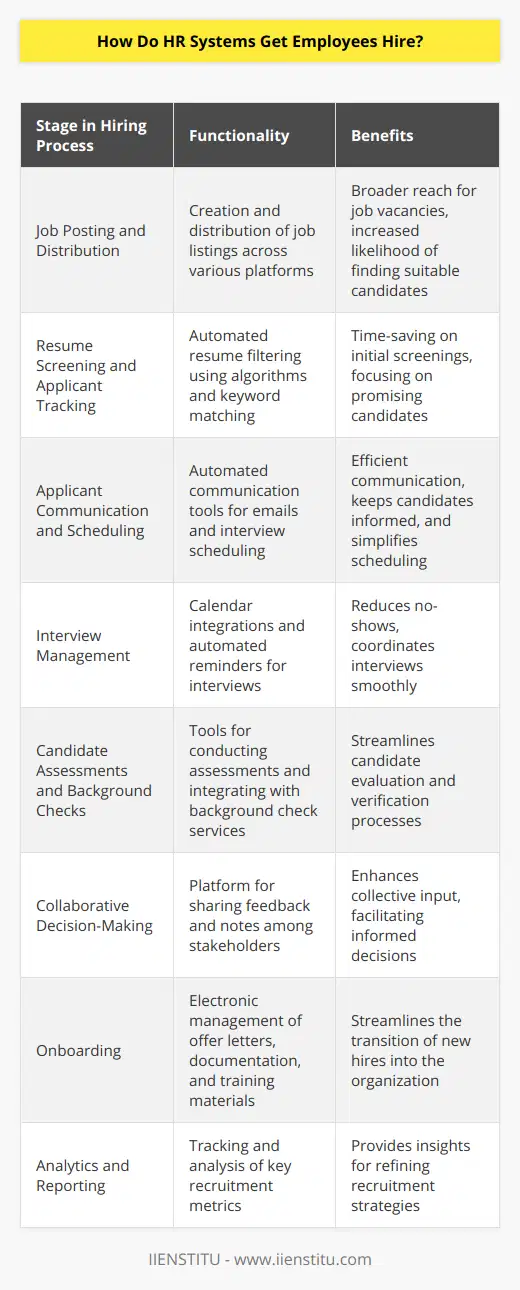
What is the HRM system and its role in organizations?
Understanding HRM Systems
The Human Resource Management (HRM) system is an integral component of any organization, ensuring the effective management of human resources such as recruitment, training, and performance evaluation. In essence, the HRM system connects individuals with relevant skills and capabilities to suitable positions within organizations, fostering successful and sustainable operations.
Role of HRM in Recruitment
A core function of the HRM system is to facilitate the recruitment of suitable candidates for open positions, ensuring that organizations maintain a competent workforce. This involves identifying ideal candidates, conducting interviews, and making informed hiring decisions based on individual competencies and alignments with company values and objectives.
Employee Training and Development
Another essential element of the HRM system is providing employees with opportunities for growth and development. This may include facilitating on-the-job training, professional development workshops, and access to resources that enhance skillsets, promoting increased productivity and improved job satisfaction. Well-executed employee development initiatives facilitate the organization's overall goals and contribute to long-term success.
Performance Management
The HRM system also plays a crucial role in evaluating employee performance, ensuring that organizations can make informed decisions regarding promotions, terminations, and overall workforce productivity. Through objective assessments of individual performance, organizations can identify areas for improvement and implement strategies to enhance efficiency and effectiveness within the workplace.
Maintaining Positive Work Environment
Another critical function of the HRM system is to maintain a pleasant and positive working environment, which directly influences employee morale and job satisfaction. This may involve cultivating an inclusive company culture, addressing conflicts or grievances, and promoting employee health and wellbeing initiatives. A healthy and supportive workplace is essential for retaining and motivating an organization's most valuable asset: its personnel.
Compliance with Labor Laws
Lastly, the HRM system helps organizations to adhere to established labor laws and regulations, protecting both employers and employees from legal issues arising from non-compliance. This includes ensuring fair payment practices, maintaining employee records, and upholding occupational health and safety standards.
In conclusion, the HRM system is a vital component of any organization, performing a multitude of crucial functions that contribute to the overall success and stability of an organization. From recruitment and employee development to performance management and compliance, the HRM system is indispensable in managing a productive and satisfied workforce.
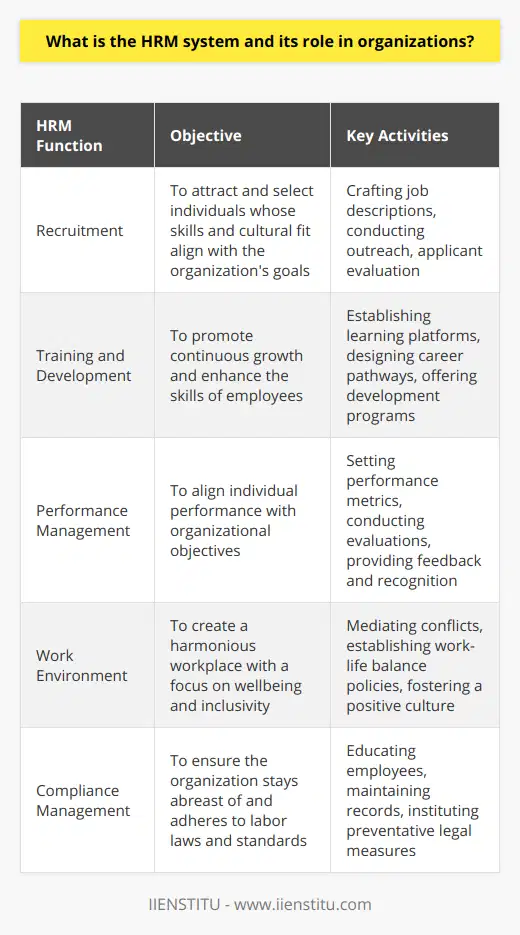
How do the 4 HR systems contribute to effective human resource management?
Role of the Four HR Systems
Effective human resource management (HRM) encompasses several key functions, which often consist of four main systems. These systems contribute to overall HRM effectiveness by ensuring the seamless coordination of all HR activities, thus leading to strong organizational performance.
Recruitment and Selection
The first system is the recruitment and selection process. This involves identifying talent needs within the organization, advertising positions to suitable candidates, and selecting the best applicants based on their competencies and potential. Effective recruitment and selection lead to increased employee engagement, reduced turnover, and a more skilled workforce that drives organizational success.
Training and Development
Another critical system within HRM is the training and development component. This provides employees with the necessary skills, knowledge, and capabilities to efficiently perform their respective roles. Continuous learning opportunities within the organization not only strengthen the workforce's abilities but also encourage career growth and foster employee commitment – collectively contributing to the organization's competitive advantage.
Performance Management
The third system in HRM is performance management, which entails setting performance goals, providing feedback, and conducting performance appraisals. By aligning individual goals with organizational objectives, HR professionals can ensure that employees work towards a common purpose. Performance management practices help to create a culture of high performance, where employees are motivated to improve their skills and efficiently contribute to organizational goals.
Compensation and Benefits
Lastly, compensation and benefits serve as a key HRM system. This includes designing competitive salary structures, providing employee benefits such as healthcare and retirement packages, and rewarding employees for their exceptional work. An attractive compensation and benefits package not only aids in attracting and retaining talent but also fosters employee satisfaction and commitment to the organization.
Conclusion
Effective human resource management relies heavily on the seamless execution of the four HR systems – recruitment and selection, training and development, performance management, and compensation and benefits. By integrating these systems, HR professionals can create a capable and engaged workforce, resulting in sustainable organizational growth and success.
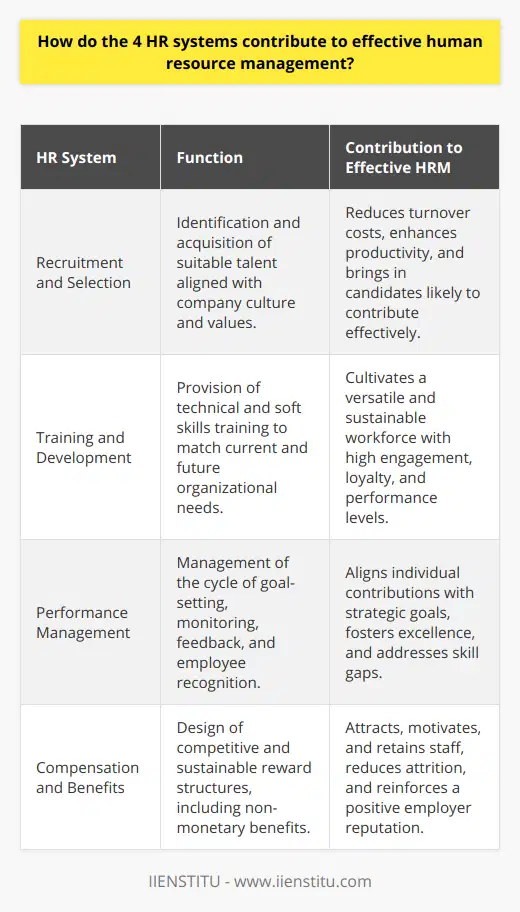
What are the key features and benefits of implementing an HRMS system?
Centralized and Efficient Data Management
One key feature of implementing an HRMS (Human Resource Management System) is centralized and efficient data management. This system allows companies to store, access, and manage all employee data in one location, simplifying tasks and reducing the risk of errors. With a centralized database, updating employee information, tracking work hours, and analyzing performance becomes systematic and streamlined.
Automation and Enhanced Accuracy
Another benefit is the automation of time-consuming administrative tasks. HRMS eliminates manual processes, such as calculating payrolls, tracking leave requests, and compiling reports, which often leads to inaccuracies or inconsistencies. By automating these tasks, HRMS enables organizations to improve their overall functioning and reduce the chances of errors, ensuring efficient and precise management.
Integration and Seamless Collaboration
The integration of various HR functions is another key feature of HRMS. It allows organizations to combine different aspects of HR, including recruitment, onboarding, performance management, compensation management, and talent management, into a single platform. This seamless collaboration between various functions improves decision-making processes and boosts overall productivity by minimizing delays or miscommunication.
Employee Self-Service Portals
HRMS also includes employee self-service portals, which empower employees to access and update their personal and professional data without requiring HR intervention. These portals promote transparency, streamline communication, and encourage employees to take ownership of their professional growth by providing relevant information about their training, development opportunities, and performance evaluations.
Analytics and Insightful Reporting
Lastly, HRMS offers analytics and insightful reporting capabilities. These tools enable organizations to analyze workforce data and track key performance indicators (KPIs) to identify skill gaps, employee achievements, retention rates, and other essential metrics. With this intelligence, organizations can make more informed decisions about employee engagement, talent management strategies, and overall workforce planning.
In conclusion, the key features and benefits of implementing an HRMS system include centralized and efficient data management, automation, enhanced accuracy, integration of HR functions, seamless collaboration, employee self-service portals, and insightful analytics and reporting. By utilizing an HRMS, companies can improve their overall HR processes, optimize decision-making, enhance productivity, and boost employee engagement and satisfaction.
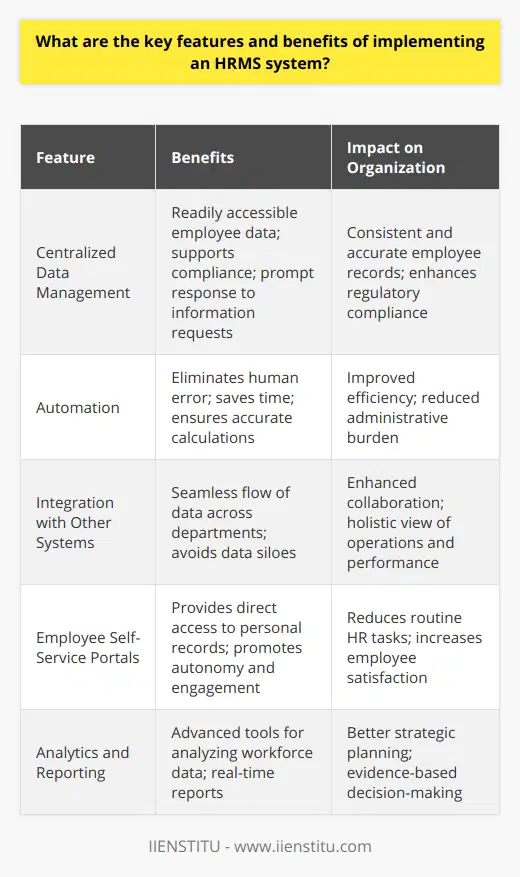
How does the integration of various HRM systems contribute to organizational success?
Integration of HRM Systems in Organizational Success
Enhancing Collaboration and Communication
The integration of various Human Resource Management (HRM) systems into an organization's operations plays a vital role in achieving organizational success. The interconnected nature of these systems promotes collaboration and communication among employees by fostering effective sharing of information and resources. This, in turn, leads to better decision-making processes.
Streamlining Recruitment and Employee Retention
Integrating HRM systems helps organizations optimize their recruitment and employee retention strategies. By employing digital platforms and tools to recruit talented individuals, organizations save time and resources. Additionally, these systems facilitate employee onboarding, ensuring a smooth transition that positively impacts engagement levels and reduces employee turnover.
Improving Performance Management
An integrated approach to HRM enables organizations to assess employee performance through comprehensive analytics and reporting regularly. This allows managers and supervisors to identify areas of improvement and provide targeted feedback and training for employees. Ultimately, a more accurate and efficient performance management system contributes to increased productivity levels and overall organizational success.
Managing Talent Development
The integration of HRM systems allows organizations to identify the professional development needs of their employees better. By utilizing e-learning platforms and training programs, organizations can enhance their employees' skills, resulting in improved performance and career growth opportunities. This investment into talent development also helps organizations maintain a competitive edge in the market.
Enhancing Employee Satisfaction and Engagement
Integrating HRM systems enables organizations to provide comprehensive benefits and incentives that improve employee satisfaction and engagement. These may include flexible work arrangements, wellness programs, and recognition initiatives, which directly impact employees' overall well-being and lead to higher job satisfaction. This results in greater loyalty and contribution to the organization's long-term success.
Supporting Strategic Decision-making
The integration of various HRM systems contributes to an organization's success by providing valuable data and insights to support strategic decision-making. Through the use of comprehensive analytics, management teams can identify trends, assess potential risks and opportunities, and make informed decisions that align with their organization's objectives.
In conclusion, integrating HRM systems plays a substantial role in achieving organizational success. By fostering collaboration, streamlining recruitment and employee retention, improving performance management, managing talent development, enhancing employee satisfaction and engagement, and supporting strategic decision-making, organizations can better achieve their goals and stay ahead in a competitive market.
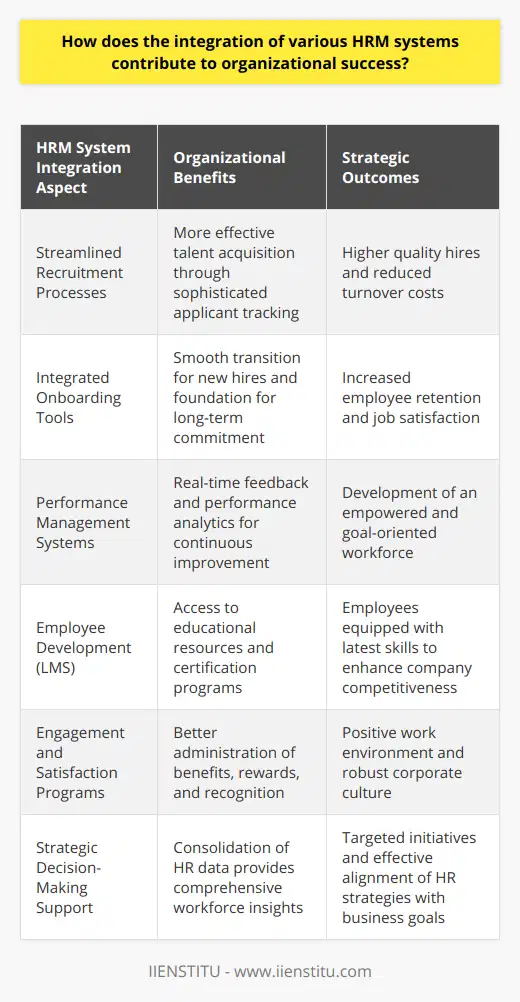
What are the potential challenges and risks associated with implementing an HRM system in an organization?
Challenges in Implementation
Implementing an HRM system within an organization poses several challenges and risks that need to be carefully navigated. One major obstacle is resistance to change from employees who are accustomed to previous systems or processes. This resistance can lead to inertia, lack of cooperation, and even hostility, ultimately hindering the successful integration of the new system.
Cost and Time Constraints
Another challenge is balancing the costs and time required for implementation. Organizations must factor in the financial expenses associated with purchasing, customizing, and maintaining the HRM system. Additionally, they must allocate ample time for the implementation and training processes while minimizing disruptions to the organization's normal operations.
Data Security Concerns
Implementing an HRM system also raises the issue of data security. Organizations need to ensure that their chosen system complies with privacy regulations and maintains the confidentiality of sensitive employee information. The risk of data breaches or unauthorized access to information can be detrimental to an organization's reputation and have legal repercussions.
Integration with Existing Systems
The integration of a new HRM system with an organization's existing infrastructure can be a complex and time-consuming process. Compatibility issues can arise, leading to the need for modifications or updates to both the HRM system and existing systems. If integration is not seamless, it can result in functionality issues, inefficiencies, and reduced productivity.
Adaptability and Scalability
Ensuring the HRM system's adaptability and scalability to meet the organization's evolving needs is another challenge. As the organization grows or undergoes changes, the system should be versatile enough to accommodate new policies, procedures, and employees without requiring significant additional investments or impeding the business's operations.
In conclusion, organizations implementing an HRM system must manage challenges such as resistance to change, cost and time constraints, data security, system integration, and adaptability. Leveraging professional support, securing employee buy-in, and thoroughly evaluating systems to ensure their suitability can mitigate these risks and contribute to a successful implementation.
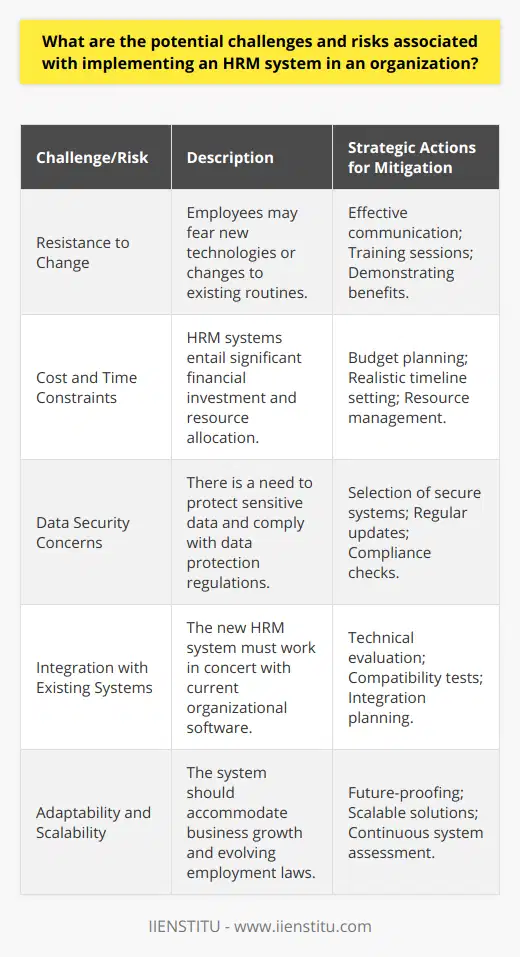
How do HRM systems ensure compliance with local and global regulations pertaining to human resources?
Effective HRM Systems
Human resource management (HRM) systems play a crucial role in ensuring compliance with local and global regulations pertaining to human resources. They streamline processes, minimize risks, and promote adherence to established laws and guidelines.
Legal Framework Adaptation
Firstly, HRM systems help adapt to the legal framework in different regions. As companies expand globally, they face various regulations and labor laws. HRM systems can efficiently maintain and update information on changing laws, allowing organizations to remain compliant in different countries.
Data Security and Privacy
Secondly, HRM systems protect sensitive employee data by ensuring compliance with local and global data privacy regulations. They employ robust security measures, such as encryption and access controls, to prevent unauthorized access and data breaches. By securing employee data, HRM systems uphold privacy rights and reduce the risk of costly penalties for non-compliance.
Policy Implementation and Monitoring
Thirdly, HRM systems facilitate the implementation and monitoring of HR policies, aligned with applicable regional and international laws. By automating administrative tasks, these systems allow HR professionals to focus on creating policies that adhere to regulations, fostering fair and transparent practices concernig employee rights, compensation, and benefits.
Employee Training and Development
Moreover, HRM systems contribute to regulatory compliance by providing training and development opportunities that inform employees about relevant laws and their rights. Through e-learning, webinars, and workshops, HRM systems educate employees on critical regulations such as discrimination, harassment, and labor rights.
Audit and Reporting
Lastly, HRM systems assist in audit and reporting processes following global and local requirements. By maintaining accurate records and generating reports, HRM systems demonstrate compliance during internal assessments, external audits, and regulatory reporting.
In conclusion, HRM systems are essential tools for companies to ensure compliance with local and global human resources regulations. By adapting to legal frameworks, securing employee data, implementing compliant policies, fostering employee awareness, and supporting audit and reporting, these systems contribute to the success and reputation of global organizations.
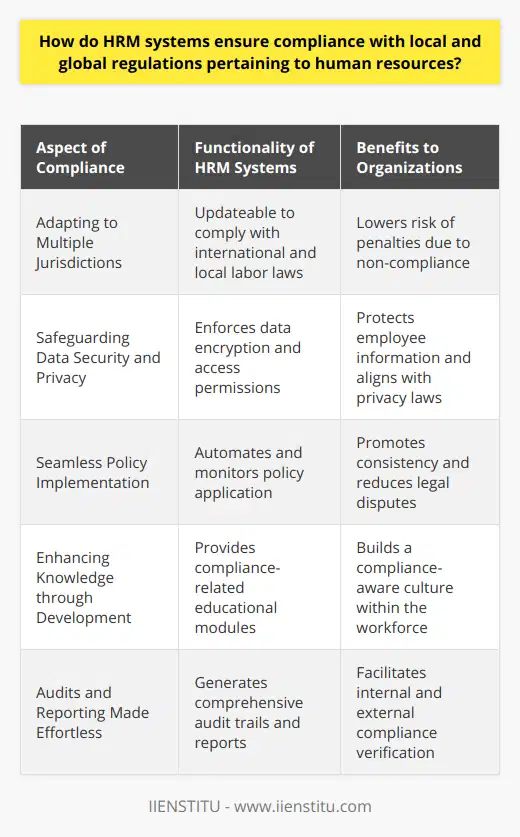
What is the HRM system and why is it important for the success of an organization?
Understanding the HRM System
The Human Resource Management (HRM) system refers to the strategic and coherent approach to managing an organization's most valuable assets: its employees. It includes a wide range of activities such as recruitment, selection, training and development, performance appraisal, compensation and benefits, and employee relations.
Significance of HRM for Organizational Success
Effective HRM plays an essential role in ensuring the organization's success as it aligns human capital with strategic goals, hence maximizing the value contributions of employees to achieve desired outcomes. Firstly, HRM aids in attracting and retaining top talent through proactive recruitment and selection processes, ensuring the organization is staffed with skilled and motivated individuals.
Fostering Employee Development
Furthermore, HRM encompasses training and development programs designed to enhance employees' skills and competencies. This not only ensures continuous improvement in staff proficiency but also contributes to increased job satisfaction, employee engagement, and ultimately greater organizational productivity. Investing in employee development to prepare them for future challenges reflects a long-term strategic vision that reinforces an organization's competitiveness in the market.
Evaluating and Rewarding Performance
Another critical facet of HRM is performance management, which focuses on setting performance expectations, monitoring progress, and providing feedback to enhance employees' performance. An effective performance management system creates a culture of accountability and drives employees to achieve the organization's objectives. Additionally, by linking performance to compensation and rewards, organizations can motivate high performers and encourage sustained excellence.
Cultivating a Positive Work Environment
Finally, HRM plays a vital role in fostering a conducive work environment where employees feel valued, respected, and supported. In this context, HRM encompasses implementing policies, fostering open communication channels, and addressing conflicts constructively. By promoting a positive work culture, organizations may successfully increase employee engagement and morale, reduce turnover, and ultimately, drive greater performance and success.
In conclusion, the HRM system contributes significantly to the success of an organization by aligning human capital with strategic goals. By ensuring the attraction and retention of top talent, fostering employee development, managing performance effectively, and cultivating a positive work environment, organizations can maximize the value of their human resources and secure a competitive advantage in the market.

What are the four main components of an HRM system and how do they collectively contribute to its overall effectiveness?
Introduction to HRM System Components
Human Resource Management (HRM) encompasses various components that collectively contribute to the overall effectiveness of an organization. These four primary components are: recruitment and selection, training and development, employee engagement, and performance management.
Recruitment and Selection
The recruitment and selection process is the first essential component, which aims to attract, screen, and choose the most suitable candidates that align with the organization's requirements and goals. This component significantly affects an organization's overall success by ensuring that each employee possesses the necessary knowledge, skills, and abilities for their respective positions.
Training and Development
The second significant component is training and development, which focuses on enhancing employees' knowledge and skills through continuous learning opportunities. By offering personalized training, coaching, and mentorship programs, organizations ensure that their workforce remains updated with industry trends and developments. This component improves productivity, boosts employee morale, and minimizes skill gaps, contributing to the overall effectiveness of an HRM system.
Employee Engagement
The third key component is employee engagement, which measures the emotional, psychological, and cognitive commitment of employees towards the organization. A higher level of engagement results in increased job satisfaction, motivation, and loyalty, which eventually leads to enhanced organizational efficiency. By implementing effective communication and feedback systems, organizations create a supportive environment that fosters healthy relationships and teamwork, ultimately impacting their HRM system's overall effectiveness positively.
Performance Management
Lastly, performance management is the fourth essential component, focusing on aligning individual and team goals with the organization's objectives. This process involves setting clear expectations, evaluating employees' performance, and providing appropriate feedback to facilitate improvement. Effective performance management systems drive employee accountability and ownership, creating a performance-centric culture that contributes to the organization's overall success.
In conclusion, the four primary components of an HRM system - recruitment and selection, training and development, employee engagement, and performance management - are crucial in achieving organizational effectiveness. By assessing the interdependence of these components and ensuring their seamless integration, organizations can optimize their HRM systems and enhance overall efficiency, productivity, and employee satisfaction.

How does the integration of an HRM system with other organizational systems lead to improved performance and efficiency?
Integration Benefits
The integration of a Human Resource Management (HRM) system with other organizational systems leads to improved performance and efficiency in several ways. Firstly, it facilitates cross-functional collaboration and communication. When HRM processes and data are integrated with other operational systems, employees from diverse departments can access relevant information and work together more effectively.
Data Accessibility and Accuracy
Improved data accessibility can minimize errors and redundancies, ensuring that all employees have real-time, accurate information. This consolidation of data streamlines decision-making processes and supports evidence-based management practices. With a single, up-to-date source of information, organizations can identify and prioritize the necessary actions, enhancing overall effectiveness.
Streamlined Hiring and Onboarding
Integrating HRM systems with recruitment and onboarding platforms can simplify and expedite these processes. Through automation and the seamless flow of candidate data, hiring managers can make faster and better-informed decisions. New employees can also access critical information, complete required documentation electronically, and begin contributing to the organization more quickly.
Efficient Task Management
An integrated HRM system allows for better task management as well. By connecting HRM functions with project management platforms, managers can easily allocate resources and assign tasks, avoiding the duplication of work and ensuring optimal use of workforce capacities. Moreover, employees can track their progress, receive feedback, and adapt their workload accordingly.
Enhanced Training and Development
A comprehensive HRM system can enhance employee training and development by linking individual performance data with suitable training programs. This enables organizations to offer targeted development opportunities, fostering continuous growth and improvement. Furthermore, integrated systems can help monitor the effectiveness of training initiatives, adjusting strategies as needed to maximize return on investment.
Improved Regulatory Compliance
Lastly, integrating HRM systems with other organizational systems can help streamline regulatory compliance. By automating and centralizing record-keeping, organizations can more easily track and demonstrate compliance with various legal and industry requirements. This not only reduces the risk of non-compliance but also minimizes the administrative burden on HR teams.
In conclusion, integrating an HRM system with other organizational systems fosters collaboration, improves decision-making, and streamlines various HR processes. These efficiencies ultimately contribute to enhanced organizational performance and employee satisfaction, making integration an essential component of effective human resource management.
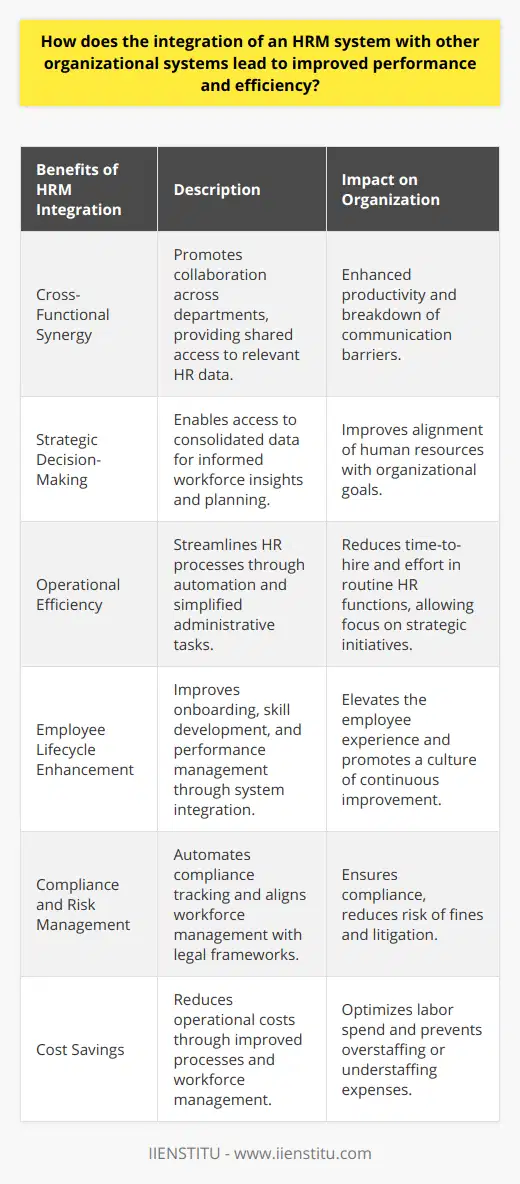
How does a comprehensive HRM system contribute to the overall development and retention of an organization's workforce?
Role of HRM in Workforce Development
The implementation of a comprehensive Human Resource Management (HRM) system plays a vital role in the overall development of an organization's workforce. It is essential in ensuring that employees are equipped with the necessary skills and competencies to meet the ever-evolving needs of the organization.
Learning and Development Initiatives
An HRM system offers various learning and development initiatives to enhance employees' knowledge, skills, and abilities. These initiatives may include skill training, workshops, seminars, mentoring programs, and access to online courses. Through these efforts, employees become more proficient, adaptable, and equipped to handle the challenges faced within their roles.
Talent Management Strategies
Another key aspect of a comprehensive HRM system is the implementation of effective talent management strategies. HRM professionals work closely with management to identify high-potential employees and invest in their development. This may involve providing valuable feedback, creating growth opportunities, and facilitating increased responsibility. These targeted efforts contribute to the organization's overall success by promoting a high-performing workforce that is prepared to take on critical roles in the future.
Employee Engagement and Retention
A successful HRM system also recognizes the importance of building a positive work environment where employees feel motivated and engaged. This may be achieved through the implementation of effective performance management systems, fostering an inclusive organizational culture, and offering competitive rewards and perks. An engaged workforce not only contributes to higher productivity but also increases the likelihood of employee retention, ultimately decreasing turnover costs.
Career Planning and Succession Planning
Finally, a comprehensive HRM system also ensures that employees have a clear understanding of their career goals and the support needed to achieve them. HRM professionals assist employees in articulating their career aspirations, offering guidance on potential career paths, and ensuring they are aligned with the organization's goals. Additionally, succession planning initiatives further contribute to talent development and retention by preparing employees for future leadership roles.
In conclusion, a comprehensive HRM system contributes immensely to the overall development of an organization's workforce. Learning and development initiatives equip employees with essential skills, while talent management strategies encourage growth and adaptability. In tandem with employee engagement and retention efforts, HRM professionals also support career planning and succession initiatives to prepare employees for long-term organizational success.

What are the essential best practices that organizations should follow when selecting and implementing an HRM system?
**Identify Organizational Needs**
The first essential practice for organizations when selecting and implementing an HRM system is identifying their specific needs. By conducting a thorough analysis of current HR processes and workflows, organizations can better understand the functionalities and features required from an HRM system. This step also helps to align the technology with organizational objectives, such as employee engagement, productivity, and compliance.
**Involve Key Stakeholders**
Involving key stakeholders, including HR professionals, management, and employees, is crucial in the selection and implementation process. By gathering input from these stakeholders, organizations can ensure the chosen system meets user needs, facilitates integration with other software platforms, and focuses on initiatives that are important to the organization's success.
**Evaluate System Features and Capabilities**
Before finalizing an HRM system, organizations must evaluate the features and capabilities of various products available in the market. This evaluation should include assessing the ease of use, customization options, scalability, and integration with other existing systems. Additionally, it is crucial to consider the vendor's reputation, customer support, and future development plans.
**Develop a Comprehensive Implementation Plan**
A comprehensive implementation plan is necessary for a seamless transition and integration of an HRM system. This plan should include timelines, resources allocation, training programs, and data migration strategies. It is also essential to establish clear roles and responsibilities for team members, ensuring that each person has the skills and knowledge required to contribute effectively to the implementation process.
**Conduct Training and Communication**
Organizations should prioritize training and communication throughout the implementation process. Providing employees and HR staff with the skills and knowledge necessary to navigate and utilize the HRM system is vital in maximizing its benefits. Moreover, ongoing communication keeps everyone informed of the progress, changes, and anticipated outcomes.
**Monitor the System and Evaluate Performance**
Once an HRM system is in place, organizations must continuously monitor its performance and assess its impact on HR processes. This may involve conducting regular audits, analyzing system-generated reports, and gathering feedback from users. By doing so, organizations can identify any areas of improvement, fine-tune the system, and ensure the technology continues to support HR objectives.
In conclusion, the essential best practices in selecting and implementing an HRM system include identifying organizational needs, involving key stakeholders, evaluating system capabilities, developing a comprehensive plan, conducting training and communication, and monitoring the system's performance. By following these practices, organizations can ensure a successful implementation, enhancing their HR processes, and maximizing the system's benefits.

How do HRM systems help in fostering positive employee-manager relationships and enhancing employee engagement within an organization?
Role of HRM Systems in Employee-Manager Relationships
Human Resource Management (HRM) systems play a crucial role in fostering positive employee-manager relationships and enhancing employee engagement within organizations. These systems streamline the communication process between employees and managers, ensuring transparent and open dialogue. Consequently, this optimizes workplace interactions, reduces misunderstandings, and prevents potential conflicts.
Effective Performance Management
A critical component of HRM systems is performance management. By setting clear expectations and goals, managers can effectively guide and support employees in achieving their objectives. Regular feedback and recognition of accomplishments reinforce the employee-manager relationship, promoting mutual trust, understanding, and satisfaction. This, in turn, increases employee engagement and commitment.
Training and Development Opportunities
HRM systems also facilitate the identification of employee strengths and areas for improvement. By providing training and development opportunities, organizations empower employees to enhance their skills and grow professionally. This continuous learning culture demonstrates the organization's commitment to employee growth and development, fostering positive employee-manager relationships, and boosting employee motivation and engagement.
Work-Life Balance Initiatives
To ensure employees remain productive and satisfied, HRM systems can implement and monitor work-life balance initiatives. Flexible working hours, telecommuting, and mental health support programs demonstrate an organization's concern for employees' well-being. These measures also promote a supportive employee-manager relationship, leading to increased trust and engagement.
Employee Involvement and Participation
Finally, HRM systems can offer platforms for employee involvement and participation in decision-making processes, enabling employees to voice their opinions and contribute to the organization's objectives. This collaborative approach strengthens the employee-manager relationship, creating a more inclusive work environment that promotes trust, commitment, and engagement.
Overall, HRM systems contribute to fostering positive employee-manager relationships by providing tools and strategies that facilitate communication, performance management, continuous learning, work-life balance, and workplace collaboration. Investing in such systems is essential for organizations to enhance employee engagement, improve retention, and ultimately achieve long-term success.
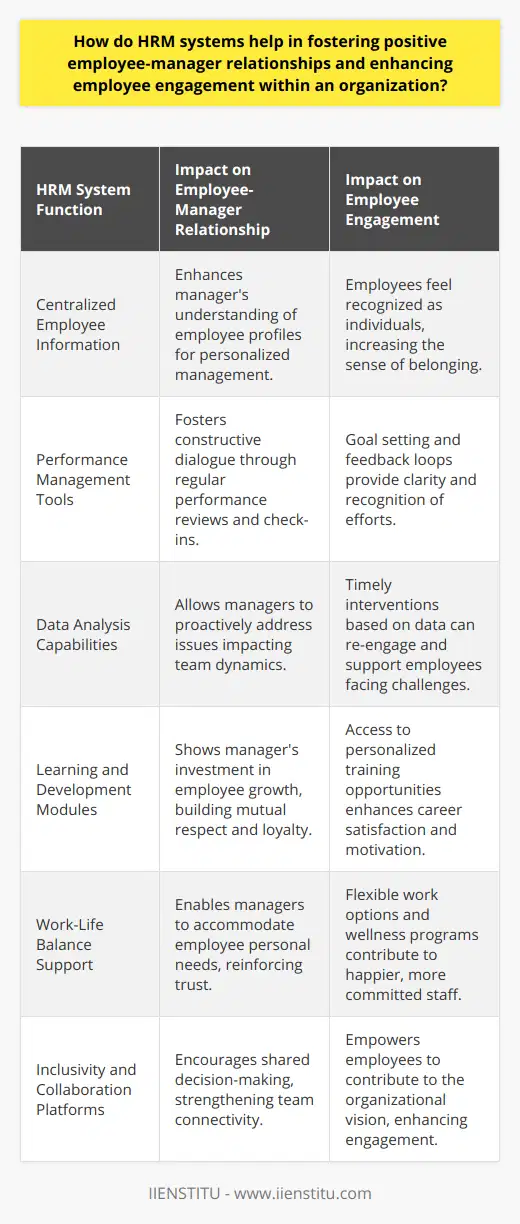
How does HRM system work to achieve efficient workforce planning and management?
Role of HRM in Workforce Planning
The human resource management (HRM) system plays a crucial role in attaining efficient workforce planning and management. It involves a series of processes and strategies designed to recruit, train, develop and retain a high-quality workforce. Central to this effort is aligning the organization's business objectives with human resource capabilities.
Recruitment and Selection Process
Efficient workforce planning and management begin with the recruitment and selection process. HRM systems facilitate the identification of job vacancies, the development of job descriptions, and the sourcing of potential candidates. Through a well-structured selection process, HRM professionals ensure that only the best candidates are hired to fill open positions. This, in turn, enhances the overall productivity and performance of the organization.
Training and Development
An essential component of HRM is investing in employee training and development. This involves identifying skill gaps, designing training programs, and evaluating their effectiveness. Training and development initiatives enable the workforce to acquire the necessary skills and knowledge to excel in their roles. As a result, a well-trained workforce contributes to improved efficiency, productivity, and competitiveness in the market.
Performance Management
Effective performance management is critical to workforce planning and management. HRM systems monitor employee performance, set goals, and provide feedback to improve individual and organizational outcomes. These processes help identify high-performing employees, who can be groomed for future leadership positions, and those who need additional support or resources. Consequently, performance management enables the organization to optimize its workforce and achieve its strategic objectives.
Retention Strategies
Retaining top talent is a priority for any organization aiming for efficient workforce planning and management. HRM systems provide the framework for developing and implementing employee retention strategies. These may include offering competitive compensation and benefits, maintaining a positive work environment, and fostering career development opportunities. Employee retention helps ensure that organizations maintain a stable workforce, thereby reducing turnover costs and enhancing overall productivity.
In conclusion, the HRM system plays a vital role in achieving efficient workforce planning and management by integrating recruitment, training, performance management, and employee retention strategies. By aligning organizational objectives with human resource capabilities, HRM enables organizations to optimize their workforce and attain their business goals.
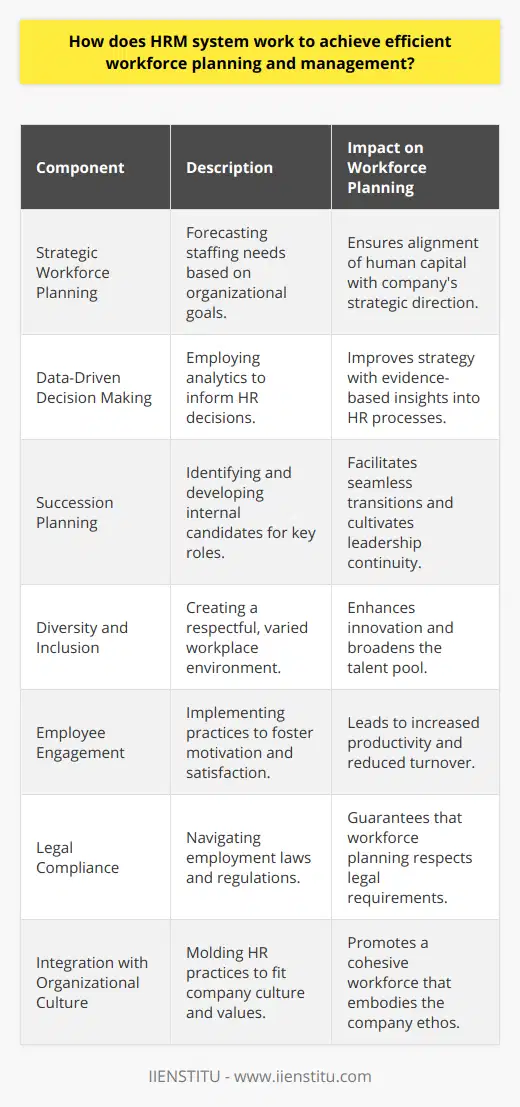
What is the impact of HRM system implementation on recruitment, training, and performance evaluation processes?
Impact on Recruitment
The implementation of a Human Resource Management (HRM) system significantly affects recruitment by streamlining and automating the hiring process. It allows for better job posting, applicant tracking, and candidate evaluations. As a result, organizations can find the most suitable candidates more efficiently and quickly, ultimately leading to a stronger workforce.
Influence on Training
HRM systems also have a considerable impact on employee training and development programs. By centralizing training materials, resources, and schedules in one platform, HRM systems make it more accessible and convenient for employees to access and monitor their progress. Additionally, the system allows HR managers to track the effectiveness of training programs and make data-driven decisions for improvement. This leads to a better-trained workforce with the skills necessary to meet the organization's goals and objectives.
Effect on Performance Evaluation
Finally, HRM system implementation significantly transforms performance evaluation processes by providing a standardized and transparent approach to assessing employee performance. Through the use of key performance indicators (KPIs), goal-setting, and regular feedback, HRM systems can help organizations develop a more objective and constructive evaluation method. Consequently, employees and managers can identify areas of improvement, recognize high-performers, and foster a culture of continuous development and achievement.
In conclusion, the implementation of an HRM system can revolutionize recruitment, training, and performance evaluation processes by ensuring efficiency, transparency, and data-driven decision-making. Organizations that adopt such systems are better equipped to attract skilled employees, develop their workforce, and maintain a high-performing and motivated team.

Can you provide a real-life example of an organization that has successfully implemented an HRM system, and explain how it has benefited their operations?
Real-Life Example: Google's HRM System
Google, a technology powerhouse with a strong Human Resource Management (HRM) system, serves as a prime example. The company's HRM system, known as People Operations, is driven by the core principles of creating a unique workplace culture, promoting innovation, and nurturing employees' well-being.
Cultivating a Unique Work Culture
A key benefit of Google's HRM system is the cultivation of a distinctive work culture that sets it apart from competitors. Through its focus on fostering a sense of belonging, Google's HRM system has successfully enhanced employee satisfaction, leading to a positive impact on productivity and innovation.
Promoting Employee Innovation and Creativity
Furthermore, Google's HRM system encourages employee innovation and creativity. For example, the famous '20% time' policy allows employees to allocate 20% of their work time to pursue personal projects, leading to the development of successful products, such as Gmail. This strategy has proven invaluable in maintaining Google as a leader in its industry.
Prioritizing Employee Well-Being
The HRM system at Google also emphasizes employee well-being, resulting in tangible benefits for the organization. By providing a comprehensive suite of perks, including free healthy meals, on-site fitness centers, and flexible work arrangements, Google has effectively minimized employee burnout and attrition rates. This investment in employee well-being ultimately contributes to the company's overall operational efficiency.
Recruitment and Talent Retention
Google's HRM system effectively supports recruitment and talent retention by adopting a rigorous selection process and offering competitive compensation packages. These efforts assist in attracting and retaining top talent, ensuring that the company's workforce is highly skilled and contributes positively to the organization's success.
Adopting a Data-Driven Approach
Lastly, a major driving force behind the success of Google's HRM system is its data-driven approach. Utilizing sophisticated data analysis techniques and tools enables the company to make informed decisions on the workforce, measure the effectiveness of HR interventions, and adjust strategies accordingly.
In conclusion, Google's HRM system, with its unique workplace culture, emphasis on employee innovation and well-being, sophisticated recruitment and retention practices, and reliance on data-driven decision making, has significantly benefited the organization by enhancing productivity, driving innovation, and maintaining a highly skilled workforce. As a real-life example, it demonstrates that a well-implemented HRM system can play a crucial role in shaping the success of an organization.
